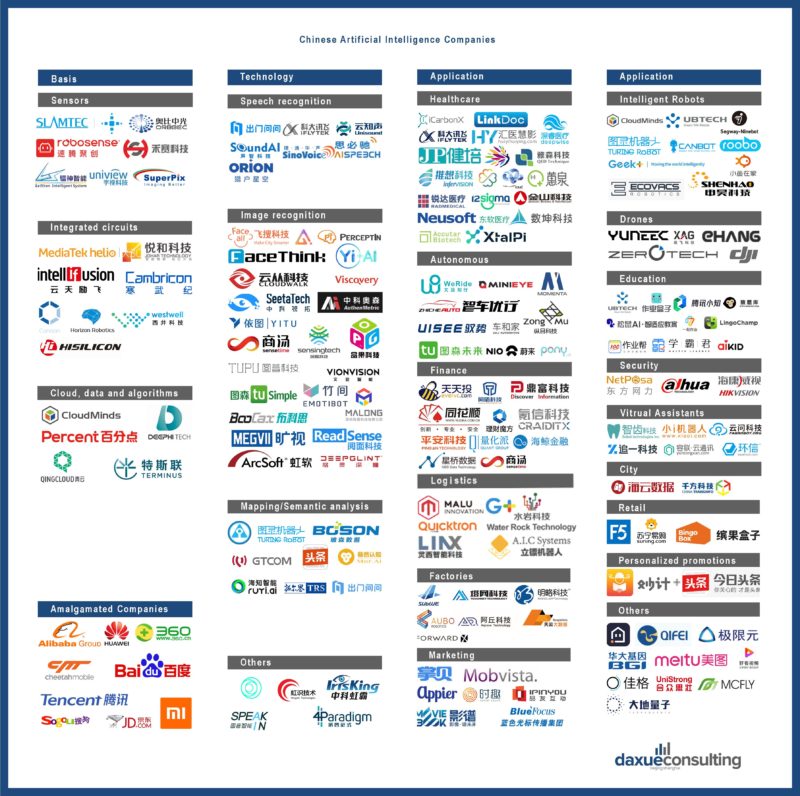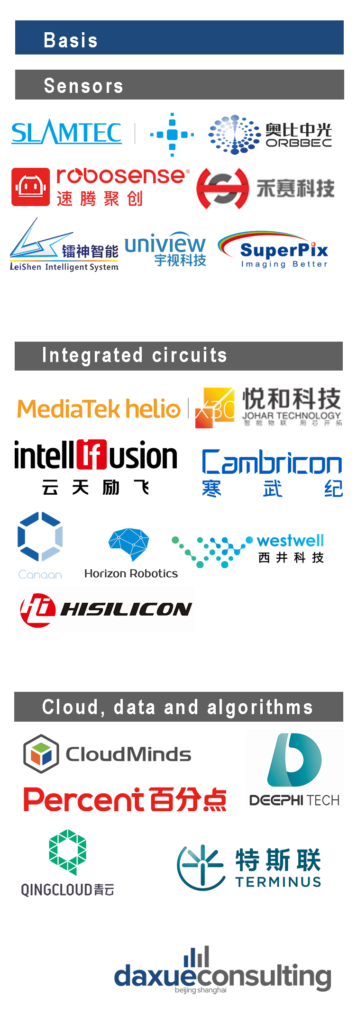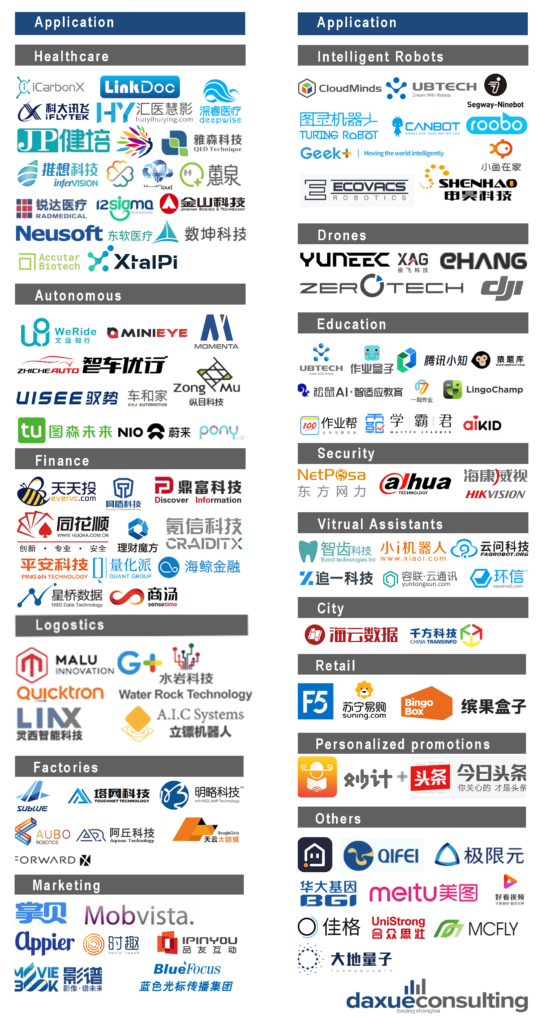Artificial intelligence is the driving force of our current global technological transformation. The artificial intelligence industry in China is impacting both the economy and daily lives of Chinese people and is widely used across many industries.
According to the 2019 China New Generation Artificial Intelligence Development Report, the AI landscape in China consists of more than 3,000 companies.
Daxue Consulting has organized the top AI companies in China by segmenting them into 4 sections based on type of AI technology. Inside each segment, there are groups based on the industry. 4 main segments are Applications, Amalgamated Companies, Basis, and Technology.

Chinese AI companies segmentation: Basis Companies
Basis-AI companies provide computing power for the whole artificial intelligence industry in China. The hardware part includes integrated circuits, sensors, and middleware; The software part provides Cloud computing platforms for the entire AI industry chain.
Massive data makes a big contribution to the development of the AI landscape in China. In the commercial development of artificial intelligence, the use of high-quality and high-correlation data can quickly improve the accuracy of AI algorithms, enabling them to be applied to more industries faster and more accurately.
China has the largest population base in the world, and it is the most extensive producer of data. At present, machine learning technology based on deep learning is inseparable from a large amount of data for inference. Therefore, massive data has become one of the most critical resources for the development of artificial intelligence frontier technology. At present, China has made significant progress in computer vision and semantic understanding algorithms based on the development of data volume.
The algorithm as an engine of artificial intelligence technology is mainly used for calculation, data analysis, and automatic reasoning.
Basis layer subcategories:
- Integrated circuits
- Sensors
- Cloud, data, and algorithms


In this layer, we could find companies such as Cambricon, Orbbec, Horizon Robotics, and others.
Chinese AI companies segmentation: Technology layer
The technical layer is referred to application algorithms such as computer vision, intelligent speech, and natural language processing.
The technical layer provides general AI technology capabilities for the overall industry chain.
This layer includes two machine-aware tasks: Image recognition and speech recognition, which are relatively mature in the current technology. Mapping/Semantic analysis is also one of the core areas. Mapping/Semantic analysis provides technical application services such as deep learning and pattern recognition to dock application layer.
At present, the Chinese domestic startups directly targeting the customers are mostly concentrated in the technical layer, such as Iflytek, which provides voice services, Sensetime Technology, which serves smartphone companies.
Technology layer subcategories:
- Speech recognition: allows the machine to automatically recognize and understand spoken language through signal processing and recognition techniques, and convert them into text and commands.
- Image recognition: similar to human eyes, the vision of the machine to identify, to track and to measure targets.
- Mapping/Semantic analysis: Understand the meaning of the text, simulate the human brain for analysis of the expression, and learn the neural network.

Chinese AI companies segmentation: Application layer
A huge market is a major advantage in the development of the artificial intelligence industry in China. A wide range of industries in China provides a large number of search data, rich product lines, and, therefore, market advantages. Also, the domestic and global giants drive to promote open source technology. Those two factors help entrepreneurs to break through the barriers of technology, apply artificial intelligence technology directly to the research and development of terminal products.
The application layer is based on AI technology integration and application development, which is a specific consumer terminal application and industry scenario application. Including:
Application layer subcategories:
- Healthcare
- Automation
- Finance
- Intelligent robots
- Drones
- Education
- Security
- Virtual assistants
- Cities
- Marketing
- Logistics
- Factories
- Retail
- Personalized promotions
- Others

Chinese AI companies segmentation: Amalgamated companies
Amalgamated companies are companies who work on all those 3 layers we mentioned before (Basis/Technology/Application layers). They are generally transformed from technology companies. Due to the high barriers to entry, such enterprises are small in number, but they have strong competitiveness, represented by companies such as Alibaba, Huawei, and Tencent.

To sum up, AI companies in China are mostly concentrated in the application layer, the proportion of technology layer and basis layer enterprises is relatively small; from the perspective of technology type distribution, the overall distribution is relatively homogeneous.
Author: Ziqi Miao
Now that you understand the basics of artificial intelligence in China, built on your knowledge with our AI in China White Paper.
Our report on AI in China:
Do not hesitate to reach out to our project managers at dx@daxueconsulting.com to get all answers to your questions





